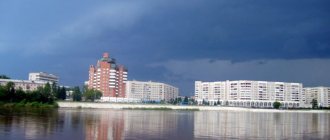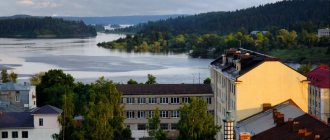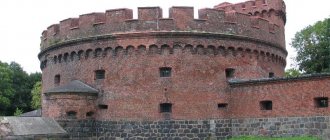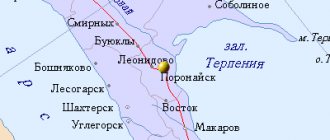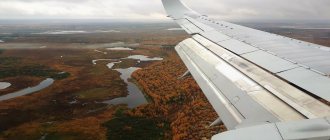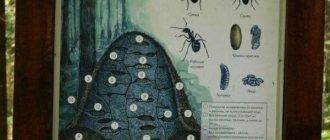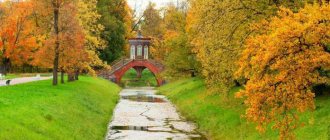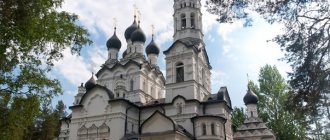Vadim Kuzmitsky Society February 20, 2018
Programmer Alexander Bravo has lived in Zelenogorsk since 1964, although he was unable to find a good job here. Now every day Alexander goes “to the city.” But he became seriously interested in local history and created a website that united other enthusiasts - history buffs - around him. Alexander BRAVO told our correspondent about what it’s like to live today in places sung by poets and writers of the Silver Age.
Multi-storey residential complexes are methodically stepping on the heels of Sestroretsk parks and public gardens. PHOTO by Sergei GRITSKOV
— Alexander Evgenievich, you spend most of your time in the metropolis. Why haven't you moved to St. Petersburg yet?
— Still, the suburbs are better suited for everyday life than a metropolis. Somehow it is more commensurate with a person. It's quiet, green, clean here. Small houses. I lived for a long time in Zelenogorsk in a Khrushchev apartment - damp, very uncomfortable. But there was a front garden next to it. We grew gooseberries, red and black currants. It was very good with children there. I put the children outside - they are in the fresh air. It’s hard to imagine this in the city.
When you come home from work, you relax. You feel like you are in some other world, where you can relax, where nature is. I couldn't refuse this. I preferred to travel two hours to work every day, but return home to Zelenogorsk.
When I got married after college, my wife—she grew up on Vasilyevsky Island—at first was eager to move back to the city. Then she got used to it too. At the same time, of course, we feel like residents of St. Petersburg and are proud of it.
I think that in Zelenogorsk the majority of the working population work in St. Petersburg. In Zelenogorsk, thank God, there is no large industry. There are only holiday homes, services, sanatoriums, shops. That's all!
— Previously, the cities and towns of the Kurortny district were perceived as summer cottages. Is this story continuing or dying out?
- To some extent, it is becoming obsolete. During Soviet times, the population in Zelenogorsk increased significantly in the summer. We have a photo of swimming in the Gulf of Finland on our website. It was called "meatball soup." Because there was simply nowhere to step in the water.
In new times, everyone who wanted sunshine flocked to Egypt and Turkey. Then the Northern Riviera somewhat lost its relevance. At the same time, surprisingly, the “non-beach” elements of dacha traditions began to revive. In the format of cultural life, which was very active before the revolution.
The festival “Towards Vyborg” has been held for ten years now. A wonderful event at the European level, organized by the Institute of Finland with the participation of city and regional authorities. As part of it, they give several concerts in villages and cities of the Karelian Isthmus. In Komarov, Repin, Penaty, Zelenogorsk and, of course, in Vyborg.
— But the tread of the metropolis is also felt in these places?
- Certainly. True, Zelenogorsk still retains its image. But, for example, Sestroretsk has largely lost it. Part of its territory was built up with high-rise buildings. And mass housing construction determines not only the appearance of the city, but also all other aspects of everyday life: transport, roads, schools, kindergartens, etc. Sestroretsk is increasingly reminiscent of a remote “dormitory” area of St. Petersburg. And this is what I would like to avoid in Zelenogorsk.
Sometimes urbanization is wild. In Zelenogorsk, in a conservation area, they tried to build two apartment buildings right on the beach. Until now, this project has not been given a proper legal assessment. Some kind of precedent decision must be made that will avoid this once and for all.
In the summer, on the border of Komarov and Zelenogorsk, entrepreneurs decided to “improve” the beach and demolish the dune, which had been formed over millennia. They needed to make it more even and lay out the paths with pebbles. If all this is not stopped, in five years we will have Shanghai for millionaires. The entire natural area will be built up with mediocre buildings. Everything will be trampled, nature will be destroyed. As a result, new buildings will lose their value. Developers themselves saw the branch they are sitting on.
— There are also plans to reclaim near the aforementioned Sestroretsk...
“I don’t understand the meaning of this idea at all.” We don’t live in China, where there is a shortage of land. We have huge free territories, and it is possible to build housing without damaging nature. Let's say the dam greatly changed the situation in the Gulf of Finland. “Outside” – in Zelenogorsk, Komarov, Repin – the erosion of the banks has intensified. Beaches are being washed out to sea and the coastline is shrinking. In general, I would ban building right by the sea once and for all.
— The cities and suburbs of the Kurortny district are famous for their old wooden buildings, which, however, are gradually disappearing. How important is it to preserve it?
— Preserving heritage is not an end in itself. It is important to preserve the Resort District as a quiet, attractive suburb for tourists. And not only for the residents of St. Petersburg, but also for the whole country and abroad. Friends often ask me to show me something interesting. And every time I show them something, I become covered in spots of shame. Because everything is falling apart, boarded up, in terrible condition. Or access is denied. To name examples of the preservation of historical heritage, the fingers of one hand will suffice.
I'm not crazy enough to demand that everything, every barn, be preserved. But even those monuments that are officially recognized by the St. Petersburg Committee for State Control, Use and Protection of Historical and Cultural Monuments, as a rule, are in appalling condition. At this rate, material evidence of the pre-revolutionary Russian period in the history of the Karelian Isthmus will simply disappear. I think this is wrong.
— What do Zelenogorsk and other cities of the Kurortny district lack?
- What is called a comprehensive development program - a master plan. There is, of course, a master plan for St. Petersburg, but at the level of Zelenogorsk this is too general a concept. There must be a comprehensive program for the development of the area as a resort area. So that this does not turn into a “dormitory” area, otherwise there will be a disaster. And from the residents’ point of view, the infrastructure must develop. Zelenogorsk, a city with a population of 14 thousand, cannot live without a cinema and concert hall. And the situation with roads is not ideal.
- But you have more than enough restaurants...
- Yes. Maybe that's enough already. When you drive along Primorskoe Highway, there is a restaurant every 500 meters. And, in my opinion, not all of them are in good shape, because we have a very high seasonality. But I don’t want to say that restaurants are basically a bad thing. Thanks to one of the restaurants, Vyrubova’s historic dacha on the border of Komarov and Repin was saved.
Georgy Vitsin will forever remain the soul of Teriyok-Zelenogorsk.
Cities to which guests of the Northern Riviera of the Silver Age took off their hats. PHOTO by Sergei GRITSKOV
#Zelenogorsk #Resort #development
Share on VKontakte Facebook
Cool
ZELENOGORSK
ZELENOGORSK, a city in Russia, in the Kurortny district of St. Petersburg. Seaside climatic resort. Population 15.3 thousand people. (2019). Located on the Karelian Isthmus, a pier on the coast of the Neva Bay of the Gulf of Finland of the Baltic Sea. Railroad station.
Story
It was first mentioned in 1548 as the Finnish village of Terijoki. In 1710 the village and its surroundings were occupied by Russian troops. It was assigned to Russia by the Peace of Nystadt in 1721. In 1744–1917 it was part of the Vyborg province (in 1802–1811/12 – the Finnish province), included in 1811 in the Grand Duchy of Finland. After the construction of the St. Petersburg – Vyborg railway in 1870, Terijoki gradually became a popular holiday destination and the largest holiday village on the coast of the Gulf of Finland (at the beginning of the 20th century, up to 55 thousand summer residents came here in the summer). Since 1910, the volost center of the Vyborg province. Since 1917, part of independent Finland, which was confirmed by the Treaty of Yuryev in 1920. In the 1930s. The development of the resort continued, many dachas were restored and reconstructed into boarding houses. During the Soviet-Finnish War of 1939–40, Terijoki was occupied by the Red Army, and the so-called government was formed here. The Finnish Democratic Republic led by O. V. Kuusinen (dissolved in 1940). According to the Moscow Treaty of 1940, it remained part of the USSR. During the Great Patriotic War, 31.8.1941, occupied by Finnish troops. Liberated on June 11, 1944 by Soviet troops during the Vyborg-Petrozavodsk operation. Since 1946 the city, in 1948 it was renamed Zelenogorsk. In 1946–59 the center of the Kurortny district of Leningrad, in 1959–89 it formed a separate administrative-territorial unit of Leningrad, in 1989–94 the center of the Zelenogorsk district of Leningrad (in 1991 renamed St. Petersburg), from 1994 as part of Kurortny district of St. Petersburg.
Architecture. Cultural centers
The following have been preserved: the Lutheran church (1907–1908, architect J. Stenbeck), the temple in honor of the Kazan Icon of the Mother of God (1910–15, architect N. N. Nikonov), the railway building. station (1917, architect B. Granholm; rebuilt in 1950, architect A. A. Grechannikov), formerly Novikov's mansion (early 20th century), formerly Villa "Ainola", a monumental high school building in the style of the Owls. classicism (1951, architect A. A. Afonchenko). War Memorial (1970s). Monuments: V.I. Lenin, Reconciliation (2004, sculptor A.A. Avetisyan). Numerous mountains sculptures and fountains. Children's Library (1963). Museum of Local Lore (2003).
In the vicinity of the city there is the Penaty estate museum, in the village. Smolyachkovo - former estate of V. M. Bekhterev Quiet Coast (late 19th - early 20th centuries), in the village. Roshchino is a Finnish monument. poetess Edith Södergran (1960s), holiday village scientific. and creative intelligentsia Komarovo (formerly Kellomyaki) with a necropolis (buried A. A. Akhmatova, N. I. Altman, D. S. Likhachev and others); historical and ethnographic museum-reserve "Yalkala" (1993), picturesque lake Bolshoye Simaginskoye (Beauty).
Farm
The basis of the city’s economy is the service sector, including tourism business and resort services; There are numerous holiday homes and sanatoriums in the city.
Finnish and Russian souls of Terijoki (now Zelenogorsk)
Zelenogorsk is located in the Kurortny district of St. Petersburg. In the past it was called Terijoki , which means “Tar River” in Finnish. There are beautiful landscapes, a mild climate, fresh sea air, a shallow sea with large sandy beaches and picturesque boulders. At the end of the 19th century, Terijoki became a popular holiday destination. Nowadays Zelenogorsk is a famous resort.
♦ On topic: Gulf of Finland of the Baltic Sea in Zelenogorsk
The shore of the Gulf of Finland in Zelenogorsk
The village of Terijoiki was first mentioned in written sources in 1548. At that time, this territory belonged to Sweden. After the end of the Northern War, it was included in the Vyborg province (then province) of the Russian Empire. The road from St. Petersburg to Vyborg passed through Terijoki. In 1811, these lands as part of the Vyborg province were transferred to the Grand Duchy of Finland.
Primorskoye Highway in Zelenogorsk
The permanent population of the village was only five thousand people, of which approximately 40% were Russians, the rest were mainly Finns. Natural beauty, mild climate, the Gulf of Finland and proximity to St. Petersburg have contributed to Terijoki becoming the largest holiday village on the coast.
Highway in Terijoki, early 20th century (Viertotie Street)
Terijoki in the 1910s
By 1908, there were about 1,400 dachas here, with more than 55 thousand summer residents coming in the summer months. In addition to dachas, fashionable resorts were also built here.
Seaside resort in Terijoki (not preserved). Photos from 1924-1926
Villa "Ainola", 1904. During the Soviet-Finnish War, the Chairman of the Government of the Finnish Democratic Republic, Otto Vilhelmovich (Otto Wille) Kuusinen, lived there. After the war, the Riviera Hotel opened here. Today it is an administrative building. Photos from 1950-1952
Over the years, Admiral S.O. Makarov, L.N. Andreev, V.V. Veresaev, N.G. Garin-Mikhailovsky, M.E. Saltykov-Shchedrin, I.P. Pavlov lived or visited here. D.I.Mendeleev, P.F.Lesgaft, V.E.Meyerhold, A.A.Blok, V.A.Serov, M.Gorky, A.I.Kuprin, A.S.Serafimovich, S.G. Skitalets, K.I. Chukovsky and other famous people of that time.
Beach on the shores of the Gulf of Finland, 1915
Not far from Terijoki, in Kuokkala (now Repino) there was Ilya Repin’s estate “Penates” , where the famous “Repin Wednesdays” were held, where artists, musicians, writers, poets, and scientists gathered.
Estate "Penates" in Repino (formerly Kuokkala)
In 1908, according to the design of the famous Finnish architect Joseph Stenbeck, the Lutheran Church of the Transfiguration of the Lord . Today, Lutheran services are held here, organ concerts are held, and Finnish language courses are held.
Lutheran-Evangelical Church of the Transfiguration of the Lord
Church of the Transfiguration of the Lord in Zelenogorsk today
Interior decoration of the church
Not far from the church in 1910-1914, an Orthodox temple was erected - the Church of the Kazan Icon of the Mother of God .
Terijoki. Church of the Kazan Icon of the Mother of God, photo taken between 1915-1935
Orthodox Church of the Kazan Icon of the Mother of God today
After the October Revolution, Terijoki found itself on the territory of the Republic of Finland. The state border with the USSR passed relatively close to it, along the Sestra River near Sestroretsk . After the winter Soviet-Finnish war of 1939-1940, Terijoki, like the entire Karelian Isthmus, went to the Soviet Union, but in 1941 this territory was reoccupied by the Finns. In 1944, Terijoki finally became Soviet.
Monument to Lenin in Zelenogorsk, behind it is a building built in 1950-1951
In 1946, Terijoki was given city status, and in 1948 it was renamed Zelenogorsk. A sanatorium-resort area was organized on the coast of the Gulf of Finland: new sanatoriums and boarding houses were built, pioneer camps appeared. In 1994, the Zelenogorsk district was included in the Kurortny district of St. Petersburg.
Fountain "Girl Ude", early 1950s
In Zelenogorsk, buildings built before the revolution and during the period of the Finnish Republic have been preserved. Unfortunately, many of them are now in disrepair. There are interesting buildings from the Soviet era. The city is decorated with numerous sculptures and fountains.
Lenin Avenue
The building of the former Public Bank of the Province of Savo-Karjala. Early 20th century
Watch
Monument to French communist Raymonde Diene. Known for protesting the Vietnam War and lying down on the tracks in front of a trainload of weapons in 1950
In recent years, the coastline in Zelenogorsk has been actively developed. There are several beaches here. Some are open for free access, while others are difficult to access.
Zelenogorsk Park of Culture and Leisure. Behind the fence you can see a monument to actor Georgy Vitsin in the role of Balzaminov. Behind the park on the shore of the Gulf of Finland is Golden Beach.
Terijoki-Zelenogorsk has a complicated history. In 2004, next to the Lutheran Church, in memory of those killed in the Soviet-Finnish war of 1939-1940, a Monument of Reconciliation . On it are carved the words from the Gospel of Mark: “Have peace among yourselves.”
Monument to Reconciliation
Behind the monument is the Finnish military cemetery, where 75 Finnish army soldiers who died from 1939 to 1944 are buried.
Burial of Finnish soldiers
Zelenogorsk and the northern coast of the Gulf of Finland in general are a wonderful place to relax. Come to these lands!
Stones
The main attractions of Zelenogorsk on the map:
© Website “On the Roads of the Middle Way”, 2009-2021. Copying and reprinting of any materials and photographs from the site anashina.com in electronic publications and printed publications is prohibited.
Holidays in Zelenogorsk near St. Petersburg
Zelenogorsk, Leningrad region , is a great place to relax. Going to St. Petersburg, we thought for a long time where to stay, in the city itself or in a sanatorium in Zelenogorsk. We made the right choice when choosing a holiday in Zelenogorsk near St. Petersburg.
Zelenogorsk (until 1948 Terijoki) is a municipality within the resort area of St. Petersburg, with a population of about 15 thousand people, but in the summer season the number increases several times due to vacationers. There is no industry or production here; the main focus is sanatorium and resort recreation. The town is very beautiful and well-groomed, there are several public gardens, with many beautiful flower beds and lawns, with various plantings and flowers. In the summer season, it is a very popular vacation spot both among residents of St. Petersburg (the drive from the city is about 1 hour) and guests from other cities. There are a lot of playgrounds in the city, so your child will definitely not be bored here.
several sanatoriums and recreation centers in Zelenogorsk : the Northern Riviera sanatorium, the Aquamarine spa hotel, the Baltic Coast sanatorium, the Volna recreation center, a one-day recreation center, the Leningrad Military District military sanatorium, children's sanatoriums (former pioneer camps) " Zorka”, “Swallow”, “Zvezdochka”, “Chaika”, children’s psychoneurological sanatorium “Pioneer”, boarding houses “Sea Surf”, “White Sun”, “AEP”, “Leningradets”, rest houses “Architect”, “Enchantress” , “Zelenogorsk”, “Energetik”, “Lenvest”, ski resort “Priboy-Dvigatel”, hotel “Helios Hotel”. You can also rent a holiday house or a summer cottage , of which there are many here. Find out the cost of living , as well as book a hotel in Zelenogorsk.
Golden Beach on the Gulf of Finland
How to get to Zelenogorsk from St. Petersburg:
You can get there in two ways - by train or bus:
— by train from Finland Station , travel time is about 1 hour, on average there is one train per hour.
Finlyandsky station in St. Petersburg
— there are several buses, but we mainly used the K-400 , which runs from the Ploshchad Lenina metro station , also known as the Finlyandsky Station, and there is a bus to the Zelenogorsk railway station. The advantage of this route is that you can choose what to take directly at the station, for example, if you didn’t have time to catch the train, you can easily go to the bus or vice versa. There are also minibuses K-305 (from the Staraya Derevnya metro station), K-680 (from the Ploshchad Prosveshcheniya metro station)
The advantage of taking a bus is that it goes along Primorskoe Highway, along the coastline. In our case, it was easier to get to the sanatorium by bus.
Railway station in Zelenogorsk
from Pulkovo-1 Airport to Zelenogorsk like this: first by minibus No. 39 to the Moskovskaya metro stop (7 stops), then along the blue line of the station. Moskovskaya – st. Technological Institute-1, here we go to the red line and further from the station. Technological Institute-1 to st. Lenin Square. Well, from Lenin Square, as described above, by bus or train. The time from Pulkovo Airport to Zelenogorsk will take somewhere from 2 to 3 hours. The path from the road is not easy, so count on your strength and time on this path, so that it doesn’t turn out like ours, that we got there already late in the evening. You can get there by taxi, the cost will be from 1500 rubles.
Taxi in Zelenogorsk: there are several companies, here are some telephone numbers;; +7 (921) 946-47-65.
Sights of Zelenogorsk, or where to go and what to see:
— the main attraction of this town, in my opinion, is the Zelenogorsk Culture and Recreation Park, which is located on the shore of the Gulf of Finland. There are eateries, places for walking and relaxing, and there is also a “Golden Beach” where you can sunbathe and swim. On the territory of the park there are fields for: football, basketball, volleyball, minigolf, there is a shooting gallery, karting, and many other attractions. Near the beach there is the Terijoki yacht club , from where you can take a walk along the Gulf of Finland.”
Golden Beach
sunset
— various squares with sculptures and fountains, such as: Komsomolsky Square, Eighth March Square, Youth Square, Victory Square, Yunost Square.
— Ferris wheel , which is located in the park;
view from the Ferris wheel at the Terijoki yacht club
— Temple of the Kazan Icon of the Mother of God , which is located just above the park;
— not far from the temple there is the “Tree of Happiness,” a favorite place for newlyweds;
— fountain , which is somewhat reminiscent of the Brussels “Manneken Pis” fountain;
— museum of retro cars , the address of the museum is Zelenogorsk, Primorskoye sh., 536, how to get there and where it is located, see the link on the map.
— an ecological nature trail on Lenin Avenue (behind the railway station), suitable for a walk with a child; along the way, past beautiful nature, you will see sculptures from Russian folk tales.
ecological trail route
Having rested in Zelenogorsk, we received a lot of positive emotions. In sanatoriums and recreation centers they now provide bicycle rentals, which we rode both around Zelenogorsk itself and along the Primorskoye Highway, reaching Komarovo (I immediately remembered the song “I’ll go to Komarovo for a week before the second”).
Balzaminov performed by actor Georgy Vitsin
Before the trip, we were worried that it would be difficult to go to St. Petersburg on excursions, but we were worried in vain, the sanatorium organized excursions to all the sights of St. Petersburg and its environs.
Our articles about St. Petersburg:
— His Majesty St. Petersburg;
— St. Petersburg in September;
— Excursion from St. Petersburg to Peterhof;
— Excursion to Vyborg;
Related posts:
Section materials
January 21, 14:17
In Kudrovo, a metro and electric depot may begin to be built in a year
January 20, 09:59
The governors of St. Petersburg and the Leningrad region discussed the construction of roads and metro
January 19, 13:07
Industrial tourism is gaining popularity in Russia
January 14, 16:20
In February, tunneling to the future Brestskaya metro station will begin.
January 12, 12:56
The microchip crisis is holding back the development of the global auto industry
Where is Zelenogorsk located? — city on the map and coordinates
The city of Zelenogorsk belongs to the Krasnoyarsk Territory and is located on the territory of the Russian Federation. Zelenogorsk is located on the left bank of the Kan River. Krasnoyarsk is located 137 kilometers from the city.
Zelenogorsk coordinates:
56°06′00″
north latitude
94°35′00″
east longitude
Zelenogorsk on the World map , which can be controlled (change the scale and move the mouse)
Facts about Zelenogorsk
- In 1996, the construction of the Church of St. Seraphim of Sarov began in the city, and was completed in 2003. The height of the church temple is 35 meters. The attention of tourists is attracted by the unusual architecture - multi-colored decoration and golden domes.
- Another attraction of the city of Zelenogorsk are the city fountains. The townspeople prefer the Yenisei and Kan construction. There is also a fountain, which is popular among newlyweds, located near the Barga River.
- The Museum of Military Glory houses many interesting exhibits, including guns, airplanes, tanks, missiles, etc. The museum also provides patriotic education for children. Here you can learn about the history of Zelenogorsk.
- The Kan River flows through the city. This is the largest tributary of the Yenisei, whose length is 630 kilometers. In summer, this river is fed by rain, and in spring by melting snow. There are many trees growing on the river bank, including fir, spruce, birch, etc.
- There is a ferry crossing across the Kan River, which was built in the summer of 1962. Today, this crossing is regularly checked so that people can get from one bank to the other.
- The Bogunay waterfall is located on the Kan River, which flows through the Krasnoyarsk city of Zelenogorsk. In order to get to it, tourists need to leave the city. In summer, tourists love to swim under the waterfall.
- Since 1965, a sanatorium called “Beryozka” has been operating in Zelenogorsk. It is located on the shore of a lake surrounded by forest, so fresh air and picturesque beauty of nature are guaranteed to clients.
- Over 60 thousand people live in the city. People of different nationalities live here. Zelenogorsk was founded in 1956. The first mention of the city appeared in 1920, although at that time it was a village called Ust-Barga.
- The City Palace of Culture in Zelenogorsk is the main place where various cultural events take place. Local residents spend their free time here on holidays.
- For lovers of books and reading, the city has the Mayakovsky Library. There are several library branches throughout the city. The high level of service attracts the attention of local city residents.
- Like any other Russian city, there is a stele for those killed during the Great Patriotic War. It is located on the coast of the Kan River. It was built for the 30th anniversary of the Victory Day. Victory Alley is also located nearby.
- The Ecological Museum of Flora and Fauna was opened in 1979. This is a unique corner of nature that attracts the attention of tourists with its diversity and rare plants. The territory of the museum is 7 hectares.
- Outside of Zelenogorsk there is a rock called "Takmak". It is located on the territory of the Stolby nature reserve. This massif is very clearly visible from Krasnoyarsk. Anyone can visit the area to personally admire the beauty of nature.
- In the city of Zelenogorsk there are shuttle buses and taxis, and in the summer, tourists can get there via ferry. There are also taxis driving around the city, which are often used by tourists.
- There are many monuments in Zelenogorsk, including the monument to Lenin, the Steam Locomotive, the Foundation Stone of the city, the Victory Stele and so on.
Zelenogorsk is on the list: countries
Would you like to share the link “Where is Zelenogorsk?” with friends? :
Short link to this page: https://where.rus/zelenogorsk/
